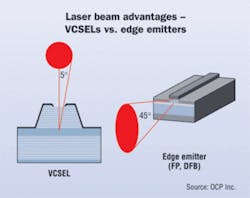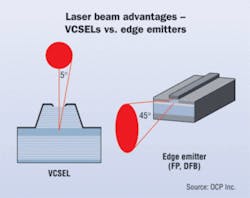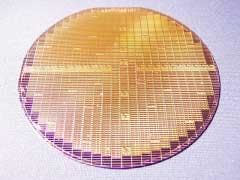Vertical-cavity surface-emitting lasers in the 1310-nm range could lower attenuation and achieve greater distances for singlemode fiber transmission-if reliability, affordability, and marketability hurdles can be overcome.
Vertical-cavity surface-emitting lasers (VCSELs) are the laser-based light source used in fiber. While VCSELs are currently available for 850-nm transmission only, and are used exclusively with multimode fiber at 1 and 10 Gbits/sec data rates, the 1310-nm operating window may be on the horizon. Longer range VCSELs will give equipment vendors the potential to significantly bring down the cost of 1310-nm singlemode fiber transmission.
VCSELs in the 850-nm range present a distance vs. bandwidth challenge for singlemode transmission, but at 1310 nm, they can take advantage of lower attenuation and achieve greater distances. While the enterprise end user world is dominated by the 850-nm VCSEL, the need for a 1310-nm range device is being driven by high-data rate applications, particularly in campus environments where they could lower network costs.
Long-range VCSELs are seen an attractive alternative to more expensive Fabry-Perot and Distributed Feedback (DFB) lasers. They offer potential packaging cost advantages over traditional edge-emitting lasers because of their low-divergence symmetrical beam profile.
DFB and Fabry-Perot lasers often require special coupling optics to focus a wide-divergence elliptical beam into a fiber, which increases the cost and complexity of optical packaging. Unlike the edge-emitting Fabry-Perot and DFB lasers, 1310-nm VCSELs are surface-emitting lasers that are easy to test during manufacturing. As a result, production yield is high and final cost is low.
1310-nm VCSELs also promise to open up new possibilities in the structured cabling market, primarily for campus backbone applications. How much, however, remains uncertain. “The telecommunications market could use them for linking the central offices together, or they could be good lower pricing drivers of fiber-to-the-home,” suggests Doug Coleman, manager of technology and standards at Corning Cable Systems (Hickory, NC; www.corning.com).
A VCSEL in every pot?
In fact, many questions abound for long-range VCSELs: If they are manufactured, will they work and be reliable over time? Will manufacturers be able to market them, and sell them at what cabling installers perceive is a cost-effective price?
And the big question-are they needed and being sought after by enterprise end users?
“It has to happen for the industry to evolve to the next level,” says Brian Ensign, senior project scientist for Leviton Voice and Data Division (Bothell, WA; www.levitonvoicedata.com).
Others believe long-range VCSELS will be of value to the longer-haul telecommunications market and public sector, but John Struhar, director of fiber structured cabling solutions for Ortronics (New London, CT; www.ortronics.com), says: “I don’t know if we will see it in the enterprise space.”
While some manufacturers report few requests for 1310-nm VCSELs, others say interest is beginning to pick up. “The big misconception is that they will take over for the 850-nm, and that is not the case,” says John George, systems engineering manager for FTTP and premises applications, OFS (Norcross, GA; www.ofsoptics.com).
George believes 1310-nm VCSELs will replace 1310-nm Fabry-Perot lasers used in the Gigabit Ethernet 1000 base LX optical transceivers, but “it’s the big misconception that when this (1310 nm) hits, 850 will die.”
Impact on structured cabling
So, why would enterprise end users need a laser that can work in the 1310-nm range?
Valerie Rybinski, global sales engineer for The Siemon Company (Watertown, CT; www. siemon.com) points out that long-range VCSELs would allow something other than 50-µm optical fiber to support 10-Gigabit Ethernet. In other words, they have the advantage of providing a longer reach than that offered by a Fabry-Perot laser.
“What this would do for enterprise applications would be to allow developers of these networking products to use one wavelength and one device to meet all the requirements as high as 10 Gigabits,” says Joseph Coffey, senior project engineer at ADC (Minneapolis, MN; www.adc.com). “It can do for the optical side of the business what the RJ-45 has done for the copper side.”
Long-range VCSELs could also let end users centralize their equipment, reducing the number of switches and routers. “This is contrary to what a lot of companies would like to see, but from an infrastructure standpoint, it has a lot of advantages for the end user,” says Coffey.
Despite the unanswered questions, the postive impact of 1310-nm VCSELs on structured cabling systems could be enormous. They will represent a laser source technology that has the speed, reach, distance and cost economics to make 10-Gigabit Ethernet pervasive throughout networks, opening the door to new installations of singlemode fiber.
It’s hard to quantify how long-range VCSELs could add to fiber installation work. Unlike 850-nm VCSELs, the 1310-nm VCSELs would have the advantage of being compatible with all legacy fiber. Instead of creating new fiber pools, the VCSELs might serve the existing market.
“So, once you get 1310 VCSELs, you can run higher speed fiber systems on legacy fiber, and the effect on the installer is you don’t have to install as much fiber,” says Jim Hayes, president of the Fiber Optic Association (Fallbrook CA, www.thefoa.org).
Long-range VCSELs also have the potential to expand the capabilities of the installed singlemode fiber base. When they are offered at a cost-effective price, end users can light the dark singlemode fiber affordably.
10-Gig challenges and potential
With data rates rising, and the 10-Gigabit Ethernet backbone as the next plateau, network designers will continue to face the challenge of optical-fiber signal transmission in the enterprise, and how to use a fiber backbone to reach the 10-Gigabit data rate. For 10-Gigabit Ethernet, high-capacity 1310-nm VCSELs will push networks to 10-Gigabit transmission rates, and while the fiber can generally handle that task, the key question is: can transceivers with the appropriate laser source technology meet these needs?
“The 1310-nm VCSEL ... holds the promise of delivering a fiber-optics transceiver through very low power consumption, at a high data rate, long transmission and for a very cost-effective price,” claims Stan Swirhun, president, Picolight Inc. (Boulder, CO; www.picolight.com). The company plans to unveil its 1310-nm VCSELs by next year.
For 10-Gigabit Ethernet over copper, 1310-nm VCSELs will offer decided advantages in the horizontal, including the potential to offer a complement to 10GBase-T. The Siemon Company’s Rybinski says the big advantage will come with the expansion of singlemode fiber backbone capabilities in campus environments, which will enable longer data transmission over the installed base.
“I am a firm believer that copper will stay in the horizontal for a long time to come,” says Rybinski. “You need a backbone that can support the growth of your horizontal cabling.”
BRIAN MILLIGAN is senior editor for Cabling Installation & Maintenance.
Manufacturers seek to overcome 1310-nm technical barriers
If 1310-nm range VCSELs are to be marketable and usable, industry leaders say they will have to perform better and be less expensive.
“We were told that we were close to seeing them three years ago, but development issues abound,” says John George, systems engineering manager for FTTP and premises applications at OFS.
“There’s been a lot of announcements during the last couple years that go back to 1998, when a company said they had a 1300-nm VCSEL,” agrees Joseph Coffey, senior project engineer at ADC. “But they couldn’t manufacture it or it was so unreliable that it wouldn’t function.”
Difficulties in reaching the 1310 wavelength have significantly delayed their deployment, and manufacturers are striving to overcome technical barriers.
Some say it could be three to 10 years before long-range VCSELs are widely deployed. Meanwhile, manufacturers know that for 1310-nm VCSELs to be saleable, they have to come up with a product that offers robustness and longevity-one that offers the same reliability of a Fabry-Perot laser. End users won’t risk networks going down and losing revenue.
JDS Uniphase is conducting tests on 1310-nm VCSELs in this range. “We’ve accumulated a few thousand hours of data, and it’s very promising,” says Wenbin Jiang, distinguished technical staff member for JDS Uniphase (San Jose, CA; www.jdsu.com).
Perhaps the biggest challenge for manufacturers is to make the 1310-nm VCSEL lasers a cost-effective package. Larry Johnson, president of The Light Brigade (Tukwila, WA; www. lightbrigade.com), argues that no company is making them in production quantity with the yields that will lower the costs.
“Manufacturers need to get that cost down,” says Johnson.-BM


